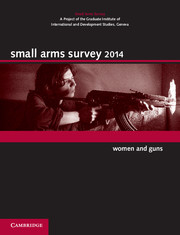Book contents
- Frontmatter
- Foreword
- Contents
- About the Small Arms Survey
- Notes to readers
- Acknowledgements
- Introduction
- Chapter 1 In War and Peace: Violence against Women and Girls
- Chapter 2 Converging Agendas: Women, Peace, Security, and Small Arms
- Special Feature. Women behind the Gun: Aiming for Equality and Recognition
- Chapter 3 Breaking New Ground?: The Arms Trade Treaty
- Chapter 4 Trade Update: Transfers, Retransfers, and the ATT
- Chapter 5 Countdown to Catastrophe: The Mpila Ammunition Depot Explosions
- Chapter 6 Across Conflict zones: Ammunition Profiling
- Chapter 7 Signs of Supply: Weapons Tracing in Sudan and South Sudan
- Chapter 8 On the Record: Illicit Weapons in the the United States
- Index
Chapter 6 - Across Conflict zones: Ammunition Profiling
Published online by Cambridge University Press: 05 July 2014
- Frontmatter
- Foreword
- Contents
- About the Small Arms Survey
- Notes to readers
- Acknowledgements
- Introduction
- Chapter 1 In War and Peace: Violence against Women and Girls
- Chapter 2 Converging Agendas: Women, Peace, Security, and Small Arms
- Special Feature. Women behind the Gun: Aiming for Equality and Recognition
- Chapter 3 Breaking New Ground?: The Arms Trade Treaty
- Chapter 4 Trade Update: Transfers, Retransfers, and the ATT
- Chapter 5 Countdown to Catastrophe: The Mpila Ammunition Depot Explosions
- Chapter 6 Across Conflict zones: Ammunition Profiling
- Chapter 7 Signs of Supply: Weapons Tracing in Sudan and South Sudan
- Chapter 8 On the Record: Illicit Weapons in the the United States
- Index
Summary
INTRODUCTION
In early 2012, the Small Arms Survey documented the presence in Libya of crates of 7.62 × 51 mm ammunition produced in Pakistan in 1981 (Jenzen-Jones, 2013a, pp. 22–23). While materiel produced more than 30 years ago would not normally raise questions about possible arms embargo violations, the Pakistani cartridges stood out in Libya, where most of the ammunition of this calibre was produced in Belgium (pp. 40–41). Furthermore, the packaging indicated that the Qatar Armed Forces were the intended recipient. The UN Panel of Experts monitoring the arms embargo on Libya found additional samples of this ammunition and approached Pakistani authorities, who confirmed that the Pakistan Ordnance Factories had shipped several million rounds of 7.62 × 51 mm ammunition to Qatar from 1981 to 1982 and concluded that ‘some of that materiel must have been re-exported to Libya in violation of obligations contained in the end-user certificate signed by Qatar’ (UN, 2013a, para. 69). This example demonstrates how profiling ammunition in circulation in particular countries can help distinguish what is common from what is unusual, and thus worthy of further examination. In this case, such data collection assisted in the investigation of possible arms embargo violations.
Investigators, researchers, war reporters, and activists are increasingly documenting ammunition found in or transferred to areas that are experiencing armed conflict.
- Type
- Chapter
- Information
- Small Arms Survey 2014Women and Guns, pp. 178 - 211Publisher: Cambridge University PressPrint publication year: 2014



